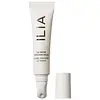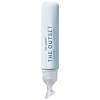What's inside
What's inside
 Key Ingredients
Key Ingredients

 Benefits
Benefits

 Concerns
Concerns

 Ingredients Side-by-side
Ingredients Side-by-side

Diisostearyl Malate
EmollientHydrogenated Polyisobutene
EmollientPolyamide-8
EmollientTribehenin
EmollientSqualane
EmollientPentaerythrityl Tetraisostearate
EmollientAroma
Opuntia Ficus-Indica Seed Oil
EmollientTocopherol
AntioxidantCocos Nucifera Oil
MaskingCaprylic/Capric Triglyceride
MaskingHexyldecanol
EmollientRicinus Communis Seed Oil
MaskingSodium Hyaluronate
HumectantButyrospermum Parkii Butter
Skin ConditioningHydrogenated Castor Oil
EmollientPentaerythrityl Tetra-Di-T-Butyl Hydroxyhydrocinnamate
AntioxidantSalicornia Herbacea Extract
Skin ConditioningBisabolol
MaskingCetylhydroxyproline Palmitamide
Skin ConditioningStearic Acid
CleansingStevia Rebaudiana Leaf/Stem Extract
MaskingGardenia Taitensis Flower Extract
Skin ConditioningBrassica Campestris Sterols
EmollientLimonene
PerfumingLinalool
PerfumingDiisostearyl Malate, Hydrogenated Polyisobutene, Polyamide-8, Tribehenin, Squalane, Pentaerythrityl Tetraisostearate, Aroma, Opuntia Ficus-Indica Seed Oil, Tocopherol, Cocos Nucifera Oil, Caprylic/Capric Triglyceride, Hexyldecanol, Ricinus Communis Seed Oil, Sodium Hyaluronate, Butyrospermum Parkii Butter, Hydrogenated Castor Oil, Pentaerythrityl Tetra-Di-T-Butyl Hydroxyhydrocinnamate, Salicornia Herbacea Extract, Bisabolol, Cetylhydroxyproline Palmitamide, Stearic Acid, Stevia Rebaudiana Leaf/Stem Extract, Gardenia Taitensis Flower Extract, Brassica Campestris Sterols, Limonene, Linalool
Oleic/Linoleic/Linolenic Polyglycerides
EmollientSqualane
EmollientShea Butter Ethyl Esters
EmollientPolyglyceryl-3 Diisostearate
EmulsifyingSynthetic Beeswax
Emulsion StabilisingCassia Angustifolia Seed Polysaccharide
Skin ConditioningHelianthus Annuus Seed Oil
EmollientLactic Acid
BufferingPalmitoyl Tripeptide-1
Skin ConditioningTribehenin
EmollientEthylhexyl Palmitate
EmollientSorbitan Isostearate
EmulsifyingPentaerythrityl Tetra-Di-T-Butyl Hydroxyhydrocinnamate
AntioxidantPhenoxyethanol
PreservativeHydroxyethylcellulose
Emulsion StabilisingWater
Skin ConditioningOleic/Linoleic/Linolenic Polyglycerides, Squalane, Shea Butter Ethyl Esters, Polyglyceryl-3 Diisostearate, Synthetic Beeswax, Cassia Angustifolia Seed Polysaccharide, Helianthus Annuus Seed Oil, Lactic Acid, Palmitoyl Tripeptide-1, Tribehenin, Ethylhexyl Palmitate, Sorbitan Isostearate, Pentaerythrityl Tetra-Di-T-Butyl Hydroxyhydrocinnamate, Phenoxyethanol, Hydroxyethylcellulose, Water
Ingredients Explained
These ingredients are found in both products.
Ingredients higher up in an ingredient list are typically present in a larger amount.
Pentaerythrityl Tetra-Di-T-Butyl Hydroxyhydrocinnamate (long name, huh?) is a synthetic antioxidant.
It is used to help stabilize other antioxidants or prevent the color from changing in a product.
As an antioxidant, it helps fight free-radical molecules. Free-radical molecules are capable of damaging our cells and other genetic material. Thus, antioxidants may reduce the signs of aging.
This ingredient is oil-soluble.
Learn more about Pentaerythrityl Tetra-Di-T-Butyl HydroxyhydrocinnamateSqualane is an emollient that helps the skin hold onto moisture. It's an oily liquid that occurs naturally in certain types of fish and plant oils.
Because squalane boosts hydration in the skin, it also comes with plenty of benefits: it is an antioxidant and can help fight free radicals and skin damage. Squalane is also found to have a detoxifying effect when applied.
Squalane comes from squalene, which occurs naturally within the sebum of our skin. It is one of the oils our skin produces to keep itself hydrated. Squalane is the hydrogenated version of squalene and has a longer shelf life.
Research shows that squalane is non-irritating (even at 100% concentration).
In general, it's a fantastic ingredient. It does a great job at hydrating the skin, and it's suitable for those with sensitive skin.
The source of squalane may impact malassezia / fungal acne. This is because olive oil derived squalane can contain impurities such as fatty acids and plant waxes. Sugarcane derived squalane is recommended for anyone with malassezia concerns.
Is squalane vegan?
This depends on the source. Squalane can be derived from both plants and animals. Most squalane used in skincare comes from plants.
Please note: the source of squalane is only known if disclosed by the brand. We recommend reaching out to the brand if you have any questions about their squalane.
Read more about squalene with an "e".
Is squalane an oil?
Squalane is often called an oil, but it’s technically not; it’s a hydrocarbon, meaning it’s only made of carbon and hydrogen, unlike true oils which are triglycerides made of fatty acids and glycerol.
The term “oil-free” isn’t regulated, so companies can define it however they want. Some exclude all oils, while others just avoid mineral oil or comedogenic oils.
While some people avoid oils thinking they cause breakouts, the right kind of oil (or oil-like ingredient like squalane) can actually help balance and hydrate your skin. It’s worth testing out simple oils or squalane to see what works best for your skin.
Learn more about SqualaneTribehenin comes from glycerin and behenic acid.
It is used as an emollient, or moisturizer. Emollients form a thin barrier on skin to prevent moisture from escaping.
This ingredient may not be Malassezia folliculitis, or fungal-acne safe.
Learn more about Tribehenin